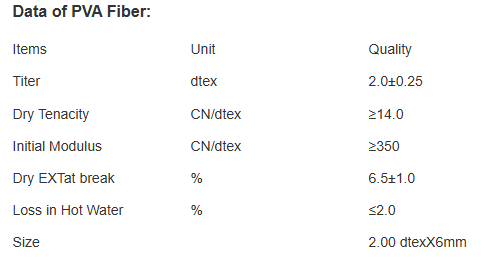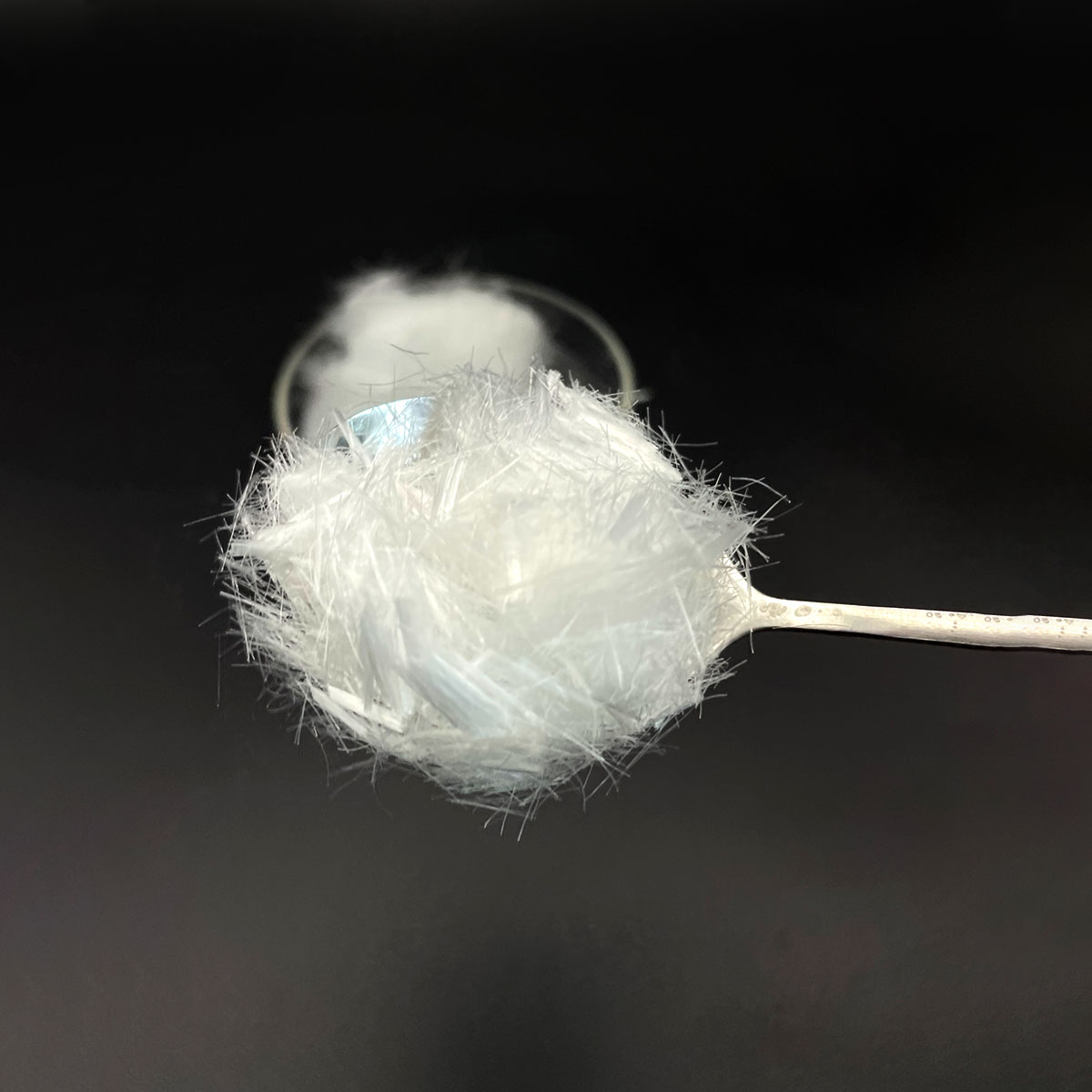Intro to PVA Fibers in Concrete
Polyvinyl Alcohol (PVA) fibers are transforming the building sector by significantly improving the performance and longevity of concrete. Derived from artificial polymers, these fibers offer impressive benefits that resolve crucial challenges in contemporary construction methods. This article explores the residential or commercial properties, applications, market fads, and future potential customers of PVA fibers in concrete, disclosing their transformative impact on building innovation.
(Parameters of TRUNNANO PVA Fiber)
The Unique Residences of PVA Fibers
PVA fibers have outstanding physical and chemical residential properties that make them perfect for enhancing concrete. They show high tensile strength, outstanding flexibility, and exceptional bonding with cementitious products. Unlike traditional steel reinforcement, PVA fibers do not rust, ensuring lasting toughness and decreasing upkeep costs. Their lightweight nature also boosts workability and pumpability, making them vital in massive building projects. In addition, PVA fibers boost split resistance and impact stamina, adding to more resilient structures.
Applications Throughout Diverse Construction Projects
1. Concrete Support: PVA fibers play a critical function in enhancing concrete, particularly in high-performance concrete (HPC) and self-consolidating concrete (SCC). They avoid micro-cracking during the onset of hydration, improving the general honesty of the framework. In precast elements and shotcrete applications, PVA fibers make sure uniform distribution and constant performance. Their addition reduces the demand for traditional support approaches, supplying cost-efficient services without endangering quality.
2. Boosted Toughness and Safety And Security: One of the standout attributes of PVA fibers is their payment to durability and safety. They dramatically improve the flexural toughness and sturdiness of concrete, making frameworks much more resistant to environmental anxieties. PVA fibers additionally boost fire resistance by creating voids within the concrete matrix when exposed to heats, stopping explosive spalling– a sensation where concrete pieces dislodge because of interior stress buildup. This improved fire resistance not only safeguards structural integrity but likewise safeguards human lives.
3. Sustainability and Ecological Influence: As sustainability becomes a priority in building and construction, PVA fibers use eco-friendly alternatives. Derived from renewable energies, they reduce waste and reduced carbon footprints. Making use of PVA fibers can reduce the quantity of cement called for, resulting in decreased carbon dioxide emissions. In addition, their durability lessens the demand for repair work and substitutes, promoting source effectiveness. Embracing lasting experiment PVA fibers lines up with worldwide efforts to develop greener and extra resistant framework.
Market Trends and Growth Vehicle Drivers: A Positive Point of view
1. Innovations in Building And Construction Innovation: Rapid improvements in building innovation demand ingenious materials that improve efficiency and effectiveness. PVA fibers meet this need by offering superior support and versatility. Smart products and advanced monitoring systems better expand their application extent, setting new criteria in the industry. The integration of PVA fibers in advanced building and construction techniques showcases their versatility and future-proof nature.
2. Increasing Concentrate On Security and Durability: With growing worries over security and durability, PVA fibers have actually come to be necessary in creating resilient and durable structures. Their capability to prevent micro-cracking and provide fire resistance addresses crucial problems in building design. The focus on safety requirements and long-lasting efficiency settings PVA fibers as a recommended option for engineers and engineers. The adoption of these fibers in high-risk atmospheres highlights their duty in ensuring architectural stability and passenger safety.
3. Economic Advantages and Cost Efficiency: Incorporating PVA fibers offers considerable economic advantages. Lowered labor expenses, fewer reinforcements, and minimized upkeep needs convert to substantial financial savings over the lifecycle of a task. For developers and contractors, the cost-effectiveness of PVA fibers makes them an attractive option without compromising quality. The equilibrium between efficiency and price makes certain prevalent adoption throughout various building and construction sectors.
Challenges and Limitations: Navigating the Course Forward
1. Technical Knowledge and Execution: Successfully integrating PVA fibers into concrete calls for specialized expertise and experience. Specialists and designers must understand optimum does, blending methods, and placement approaches to take full advantage of benefits. Bridging the gap between theoretical benefits and practical execution will certainly be important for more comprehensive fostering. Offering comprehensive training and guidelines can encourage stakeholders to harness the complete possibility of PVA fibers.
2. Standardization and Policy: Guaranteeing consistent quality and performance necessitates standard testing and regulative structures. Variants in fiber production and application can result in inconsistent results, affecting architectural honesty. Developing robust requirements and certifications will cultivate depend on and reliability in using PVA fibers. Cooperation in between makers, scientists, and regulative bodies will certainly be vital in creating globally approved standards.
(TRUNNANO PVA Fiber)
Future Prospects: Developments and Opportunities
The future of PVA fibers in concrete looks appealing, driven by the enhancing demand for sustainable and high-performance products. Ongoing research and development will certainly lead to the production of brand-new fiber types and applications, additionally broadening their utility. Technologies in wise products, 3D printing, and environment-friendly chemistry will improve the worth suggestion of PVA fibers. As sectors prioritize effectiveness, toughness, and environmental duty, PVA fibers are poised to play a pivotal function in shaping the future of building. The continuous development of these fibers guarantees interesting chances for advancement and growth.
Conclusion: Embracing the Prospective of PVA Fibers for Concrete
To conclude, PVA fibers are changing the building market by boosting the efficiency, sturdiness, and sustainability of concrete. Their one-of-a-kind residential properties and varied applications supply substantial advantages, driving market development and development. Understanding the benefits and difficulties of PVA fibers enables stakeholders to make enlightened decisions and take advantage of emerging possibilities. Embracing PVA fibers suggests welcoming a future where technology meets resilience in construction.
High Quality PVA Fibers Distributor
TRUNNANO is a supplier of PVA Fiber Materials with over 12 years of experience in nano-building energy conservation and nanotechnology development. It accepts payment via Credit Card, T/T, West Union and Paypal. Trunnano will ship the goods to customers overseas through FedEx, DHL, by air, or by sea. If you want to know more about pva fibers young’s modulus, please feel free to contact us and send an inquiry(sales5@nanotrun.com).
All articles and pictures are from the Internet. If there are any copyright issues, please contact us in time to delete.
Inquiry us






